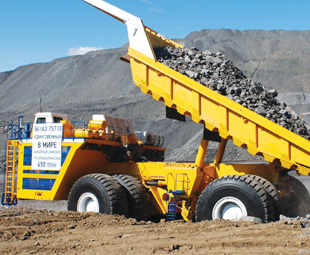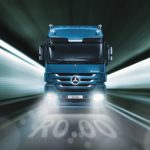A new level of of big

Mining trucks keep on getting bigger and bigger, as miners increasingly opt for huge- capacity trucks with greater operational efficiency. Take the Belaz 75710, for instance; it has a staggering 496-t payload …
A quick and simple internet search will tell you that the Belaz is considered the world’s biggest mining dump truck. Launched in October of 2013, by the Belarusian company Belaz, the truck is 20-m long, 8,16-m high and 9,87-m wide.
According to mining-technology.com, the empty weight of the vehicle is 360 t and it features eight large-size Michelin tubeless pneumatic tyres and two 16-cylinder turbocharged diesel engines. The power output of each engine is 1 716 kW (2 300 hp), and the massive vehicle uses an electromechanical transmission powered by alternating current. The top speed of the truck is 64 km/h.
The Caterpillar 797F is also considered to be one of the biggest mining trucks in the world, with a
400-t payload. It’s 14,8-m long, 6,52-m high and 9,75-m wide, The truck uses six Michelin XDR or Bridgestone VRDP radial tyres, and Cat C175-20 four-stroke turbocharged diesel engines with an overall power output of 1 193 kW (1 600 hp) and a top speed of 68 km/h.
One of the biggest suppliers of mining trucks in South Africa, Caterpillar also manufactures the 730C, the 730C EJ, 745C and the 735C three-axle articulated trucks.
South Africa is well known for its mining industry and many towns and cities have been built around the industry, as well as companies such as Bell Equipment. This mining equipment supplier manufactures the B25E 6×4 Supertruck. Considered the cost-effective version of the standard B25E, the Supertruck has a 24 000-kg payload, gross power of 205 kW (275 hp), and is 9,95-m long and 3,37-m high.
The company, founded by South Africans Irvine and Eunice Bell, also manufactures the B35D, B60D, B18E and the B60E. A prototype of the B60E was showcased at the Bauma trade show in Munich earlier this year. According to equipmentworld.com, the truck is directed at quarry and mining operations and will use a 4×4 all-wheel-drive configuration rather than the more typical 6×6.
 Bell Equipment says that it adopted the two-axle concept of a rigid truck, which the B60E is designed to replace in some applications, with a driven front axle and independent front and rear chassis. The truck boasts a 55 000-kg payload, power of 430 kW (577 hp) and is 11,114-m long and
Bell Equipment says that it adopted the two-axle concept of a rigid truck, which the B60E is designed to replace in some applications, with a driven front axle and independent front and rear chassis. The truck boasts a 55 000-kg payload, power of 430 kW (577 hp) and is 11,114-m long and
4,212-m high.
In 1966 Volvo Construction Equipment invented the world’s first articulated hauler. Its latest haulers include in A25F and the A30F. The A25F has a payload of 24 000 kg, is 10,218-m long, 2,859-m wide, 3,434-m high and has a dump height of 6,529 m.
The A30F has a payload of 28 000 kg, is 10,296-m in length, 2,941-m wide, 3,434-m high and has a dump height of 6,56 m. Other models available from Volvo are A25G, A35F, A40F, A40F FS and the massive A60H.
Choosing the right mining truck
Dump trucks (including standard, rigid-frame, articulated versions) are only some of the trucks available to the mining industry. How does a company choose the right truck for mining applications? The website constructionbusinessowner.com lists seven points that may be helpful when choosing a mining truck:
1. Evaluate the company’s needs: The equipment needs to suit the type of work that is going to be undertaken.
2. Understand the specs: Look at each truck’s specifications and all the options available to match job requirements with machine specifications. Most distributor and manufacturer websites can be used to start the process, because they offer considerable detail. Payload capacity is an important spec on which contractors should focus.
3. Consider the speed: Operators want to accelerate quickly under load, which means a truck should be selected with a high power-to-weight ratio to ensure productivity on the job. Look for a unit offering an abundance of horsepower and torque that is designed with an engine and transmission combination which allows operators to go faster and haul more in one cycle. Some trucks have an all-wheel drive system with automatic limited-slip differentials in each axle to give operators superior traction and speed in different working conditions.
4. Consider fuel efficiency during the specification process. Fuel consumption should be based more on material per litre than the amount of fuel used per hour.
5. Assess comfort features: After determining how a truck will handle the demands of the job, evaluate its comfort. Today, most articulated trucks offer ergonomically designed cabs that provide great visibility and comfort.
6. Compare service and support: Before making the investment, look at the service and support provided by the distributor and the manufacturer.
7. Questions to consider: What kind of material is being moved? How far is the material going? What kind and size of loading machine is being used? Is the cab ergonomically designed?
Published by
Focus on Transport
focusmagsa




